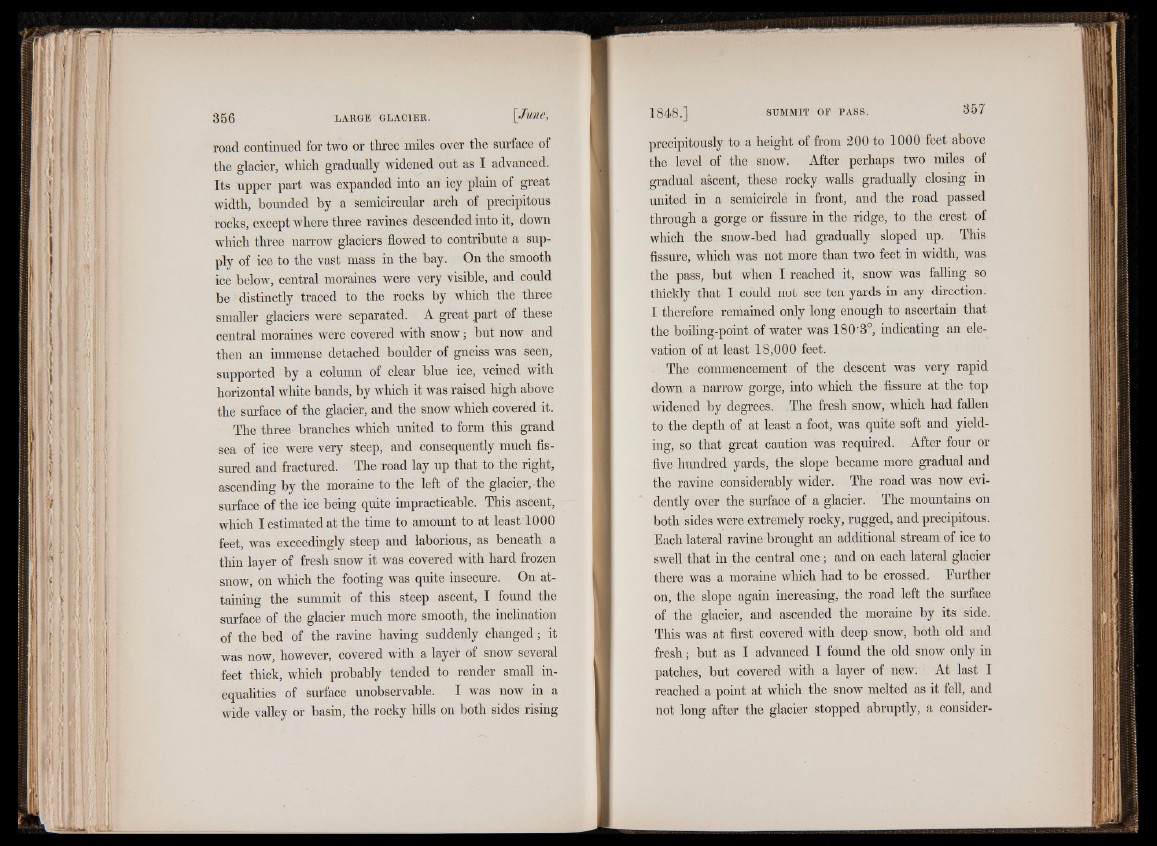
road continued for two or three miles over the surface of
the glacier, which gradually widened out as I advanced.
Its upper part was expanded into an icy plain of great
width, bounded by a semicircular arch of precipitous
rocks, except where three ravines descended into it, down
which three narrow glaciers flowed to contribute a supply
of ice to the vast mass in the bay. On the smooth
ice below, central moraines were very visible, and could
be distinctly traced to the rocks by which the three
smaller glaciers were separated. A great part of these
central moraines were covered with snow; but now and
then an immense detached boulder of gneiss was seen,
supported by a column of clear blue ice, veined with
horizontal white bands, by which it was raised high above
the surface of the glacier, and the snow which covered it.
The three branches which united to form this grand
sea of ice were very steep, and consequently much fissured
and fractured. The road lay up that to the right,
ascending by the moraine to the left of the glacier, the
surface of the ice being quite impracticable. This ascent,
which I estimated at the time to amount to at least 1000
feet, was exceedingly steep and laborious, as beneath a
thin layer of fresh snow it was covered with hard frozen
snow, on which the footing was quite insecure. On attaining
the summit of this steep ascent, I found the
surface of the glacier much more smooth, the inclination
of the bed of the ravine having suddenly changed; it
was now, however, covered with a layer of snow several
feet thick, which probably tended to render small inequalities
of surface unobservable. I was now in a
wide valley or basin, the rocky hills on both sides rising
precipitously to a height of from 200 to 1000 feet above
the level of the snow. After perhaps two miles of
gradual ascent, these rocky walls gradually closing in
united in a semicircle in front, and the road passed
through a gorge or fissure in the ridge, to the crest of
which the snow-bed had gradually sloped up. This
fissure, which was not more than two feet in width, was
the pass, but when I reached it, snow was falling so
thickly that I could not see ten yards in any direction.
I therefore remained only long enough to ascertain that
the boiling-point of water was 180-3°, indicating an elevation
of at least 18,000 feet.
The commencement of the descent was very rapid
down a narrow gorge, into which the fissure at the top
widened by degrees. The fresh snow, which had fallen
to the depth of at least a foot, was quite soft and yielding,
so that great caution was required. After four or
five hundred yards, the slope became more gradual and
the ravine considerably wider. The road was now evidently
over the surface of a glacier. The mountains on
both sides were extremely rocky, rugged, and precipitous.
Each lateral ravine brought an additional stream of ice to
swell that in the central one; and on each lateral glacier
there was a moraine which had to be crossed. Eurther
on, the slope again increasing, the road left the surface
of the glacier, and ascended the moraine by its side.
This was at first covered with deep snow, both old and
fresh; but as I advanced I found the old snow only in
patches, but covered with a layer of new. At last I
reached a point at which the snow melted as it fell, and
not long after the glacier stopped abruptly, a consider